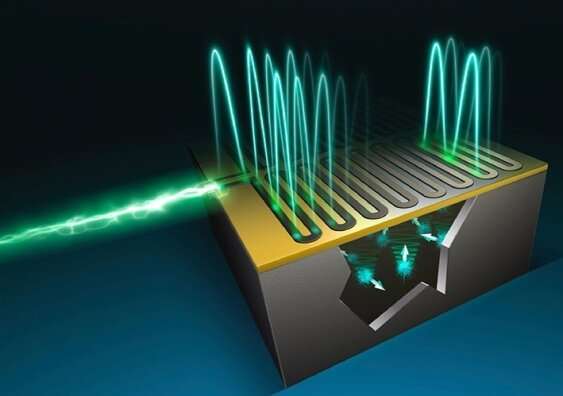This article has been reviewed according to Science X's editorial process and policies. Editors have highlighted the following attributes while ensuring the content's credibility:
fact-checked
peer-reviewed publication
trusted source
proofread
Quantum engineers design new tool to measure spins in materials with high precision

In a paper published over the weekend in the journal Science Advances, Associate Professor Jarryd Pla and his team from UNSW School of Electrical Engineering and Telecommunications, together with colleague Scientia Professor Andrea Morello, described a new device that can measure the spins in materials with high precision.
"The spin of an electron—whether it points up or down—is a fundamental property of nature," says A/Prof. Pla. "It is used in magnetic hard disks to store information, MRI machines use the spins of water molecules to create images of the inside of our bodies, and spins are even being used to build quantum computers.
"Being able to detect the spins inside materials is therefore important for a whole range of applications, particularly in chemistry and biology where it can be used to understand the structure and purpose of materials, allowing us to design better chemicals, drugs and so on."
In fields of research such as chemistry, biology, physics and medicine, the tool that is used to measure spins is called a spin resonance spectrometer. Normally, commercially produced spectrometers require billions to trillions of spins to get an accurate reading, but A/Prof. Pla and his colleagues were able to measure spins of electrons in the order of thousands, meaning the new tool was about a million times more sensitive.
This is quite a feat, as there are a whole range of systems that cannot be measured with commercial tools, such as microscopic samples, two-dimensional materials and high-quality solar cells, which simply have too few spins to create a measurable signal.
The breakthrough came about almost by chance, as the team were developing a quantum memory element for a superconducting quantum computer. The objective of the memory element was to transfer quantum information from a superconducting electrical circuit to an ensemble of spins placed beneath the circuit.
"We noticed that while the device didn't quite work as planned as a memory element, it was extremely good at measuring the spin ensemble," says Wyatt Vine, a lead author on the study. "We found that by sending microwave power into the device as the spins emitted their signals, we could amplify the signals before they left the device. What's more, this amplification could be performed with very little added noise, almost reaching the limit set by quantum mechanics."
While other highly sensitive spectrometers using superconducting circuits had been developed in the past, they required multiple components, were incompatible with magnetic fields and had to be operated in very cold environments using expensive "dilution refrigerators," which reach temperatures down to 0.01 Kelvin.
In this new development, A/Prof. Pla says he and the team managed to integrate the components on a single chip.
"Our new technology integrates several important parts of the spectrometer into one device and is compatible with relatively large magnetic fields. This is important, since measure the spins they need to be placed in a field of about 0.5 Tesla, which is ten thousand times stronger than the earth's magnetic field.
"Further, our device operated at a temperature more than 10 times higher than previous demonstrations, meaning we don't need to use a dilution refrigerator."
A/Prof. Pla says the UNSW team has patented the technology with a view to potentially commercialize, but stresses that there is still work to be done.
"There is potential to package this thing up and commercialize it which will allow other researchers to plug it into their existing commercial systems to give them a sensitivity gain.
"If this new technology was properly developed, it could help chemists, biologists and medical researchers, who currently rely on tools made by these large tech companies that work, but which could do something orders of magnitude better."
More information: Wyatt Vine et al, In-situ amplification of spin echoes within a kinetic inductance parametric amplifier, Science Advances (2023). DOI: 10.1126/sciadv.adg1593. www.science.org/doi/10.1126/sciadv.adg1593
Journal information: Science Advances
Provided by University of New South Wales




















